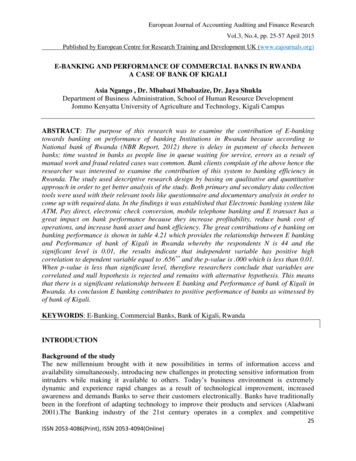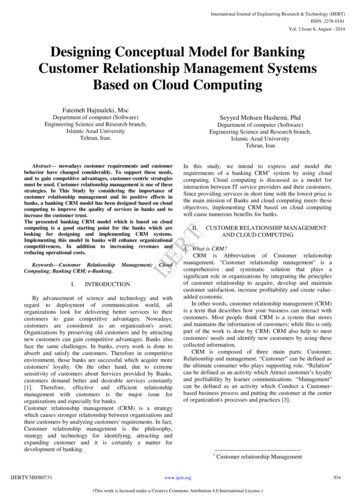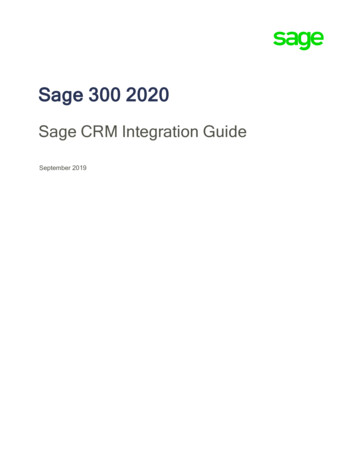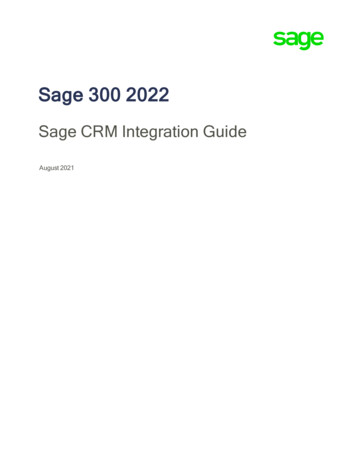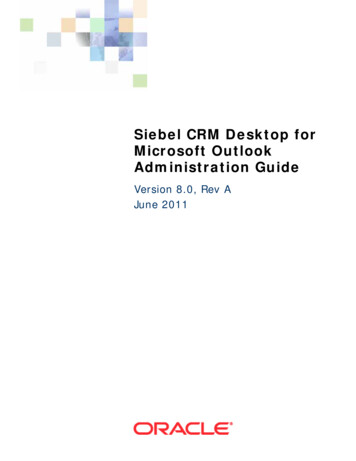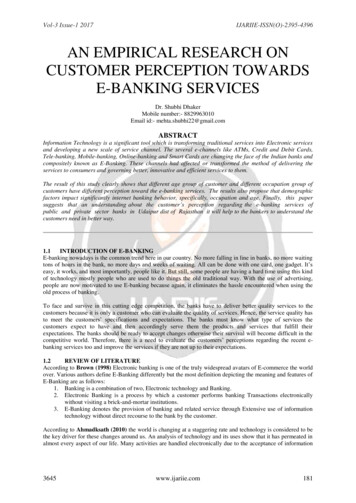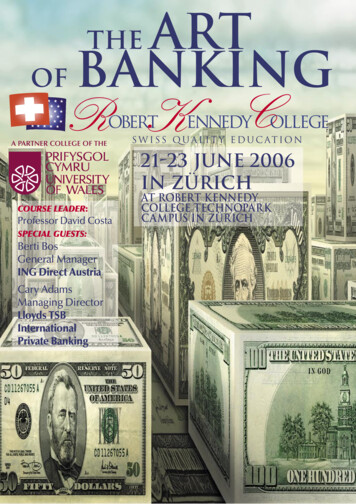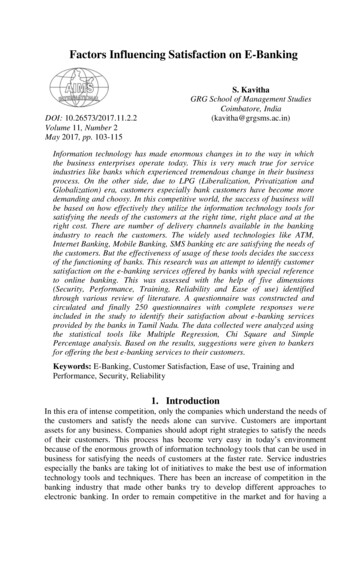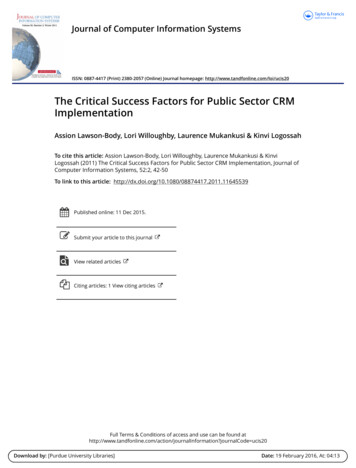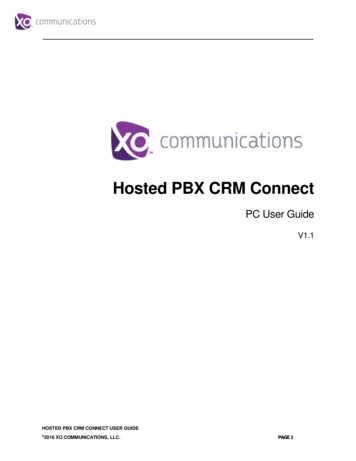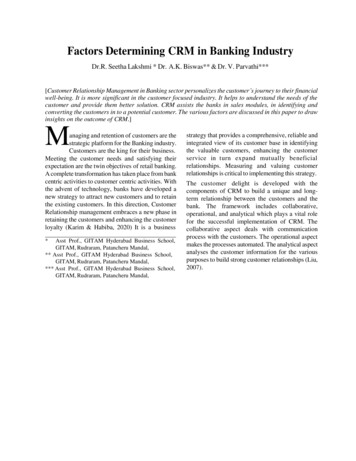
Transcription
Factors Determining CRM in Banking IndustryDr.R. Seetha Lakshmi * Dr. A.K. Biswas** & Dr. V. Parvathi***[Customer Relationship Management in Banking sector personalizes the customer’s journey to their financialwell-being. It is more significant in the customer focused industry. It helps to understand the needs of thecustomer and provide them better solution. CRM assists the banks in sales modules, in identifying andconverting the customers in to a potential customer. The various factors are discussed in this paper to drawinsights on the outcome of CRM.]Managing and retention of customers are thestrategic platform for the Banking industry.Customers are the king for their business.Meeting the customer needs and satisfying theirexpectation are the twin objectives of retail banking.A complete transformation has taken place from bankcentric activities to customer centric activities. Withthe advent of technology, banks have developed anew strategy to attract new customers and to retainthe existing customers. In this direction, CustomerRelationship management embraces a new phase inretaining the customers and enhancing the customerloyalty (Karim & Habiba, 2020) It is a business*Asst Prof., GITAM Hyderabad Business School,GITAM, Rudraram, Patancheru Mandal,** Asst Prof., GITAM Hyderabad Business School,GITAM, Rudraram, Patancheru Mandal,*** Asst Prof., GITAM Hyderabad Business School,GITAM, Rudraram, Patancheru Mandal,strategy that provides a comprehensive, reliable andintegrated view of its customer base in identifyingthe valuable customers, enhancing the customerservice in turn expand mutually beneficialrelationships. Measuring and valuing customerrelationships is critical to implementing this strategy.The customer delight is developed with thecomponents of CRM to build a unique and longterm relationship between the customers and thebank. The framework includes collaborative,operational, and analytical which plays a vital rolefor the successful implementation of CRM. Thecollaborative aspect deals with communicationprocess with the customers. The operational aspectmakes the processes automated. The analytical aspectanalyses the customer information for the variouspurposes to build strong customer relationships (Liu,2007).
Implementation of successful customer relationshipmanagement focuses on empathizing the needs anddesires of the customers and is achieved by providinga quality service and integrating them with theorganization’s strategy, people, technology andbusiness processes (Lebdaoui & Chetioui, 2020)thereby enhancing the customer loyalty. Improvingthe customer experience by prompt customerresponse, dwelling in to the needs of the customerthrough customer knowledge, improving the valueof the customers are the best way to differentiatethemselves in a competitive edge.CRM in banking industry plays a pivotal role increating the trust among the people. An adequateattention is established to customer care support,making timely information about interest payments,maturity of time deposit, issuing credit and debit cumATM card, creating awareness regarding online ande-banking, adopting mobile request which are requiredto maintain the relationship with customers. It hasgained importance with the aggressive strategies forcustomer acquisition and retention. This has resultedin the adoption of various CRM initiatives by thesebanks. With this background, the researcher has madea modest attempt to study uncovered factors whichdetermine the CRM in development and promotionof banking sector through the sidelines of the practicesand problems.Review of LiteratureThe top most priority of the banking sector is theacquisition of new customers. Understanding thetransactional behavior for the customers with differentperspectives, responding to the queries of thecustomers are the challenging task in the currentscenario. Customer Relationship managementimproves the acquisition, building a rapport betweenthe customers and banks. There is a substantial bodyof empirical literature that establishes the factorsdetermining the effective implementation of CRM.Customer AcquisitionApplying the techniques of the CRM, it boosts upthe banking customer acquisition strategy with thedepth of data and the processing capabilities. It isbeen demanded more and plays an important role inthe customer life cycle (Ang & Buttle, 2006). Theimportant element of attracting the new and thepotential customers is by the way of building a trustand an engaged customer relationship. Theconversation with the customers focuses on thecapturing the insights on different products andservices offered by the banks and making them tobelieve that their financial and non-financial needswill be met by the unique process with the help ofCRM tools.Customer ResponseThe reply to the customer queries depends upon theunderstanding and interpreting in the best way toprovide the possible solution. It is an importantcriterion to build a better relationship and to enhancethe satisfaction and loyalty with the customers.Prompt response in a professional way provides abetter avenue for smooth interaction between itscustomers, employees and enhance the satisfactionand loyalty with the customers (Shang & Lu, 2012)Customer KnowledgeCampbell (2003) defines customer knowledge as:“organized and structured information about thecustomer as a result of systematic processing”. Theknowledge is classified in various perspectives likeknowledge about customers; knowledge forcustomers and, finally, knowledge from customers(Gebert et al. 2002). The requirements of customers,is “knowledge about customers”. When the needsand desires of the customers are satisfied then, it is“knowledge for customers”. The Customerexperiences is “knowledge from customers”. Theexpectations of the customers are pooled togetherand the services are customized according to theirneeds. Understanding the demographic conditions,background of the customers, the customer segments,helps the banking industry to understand their needsand wants. Thereafter the knowledge about thecustomers helps to deliver a quality service which inturn leads to customer loyalty (Karim & Habiba,2020)Customer Information SystemCustomer information system used to access, collect,store use transmits, protect or dispose of customerinformation. It is an important tool of CRM that allowsthe user to define a virtually unlimited number offields and codes in addition to the large number ofpredefined information. It aids to understand thedifferent perspectives of customer and devising thewiser strategy to improv the performance the banking
industry. This in turn enhances the customersatisfaction and customer loyalty (Liu, 2007)Customer Value EvaluationCRM captures the holistic view of the customers onthe products and services offered to them. Thecustomers value is the weapon for devising a strategyto attract and retain the customers. It allows thebanking industry to serve the customers according totheir needs and in turn elevate the customersatisfaction and increase the loyalty of the customers.The banking industry can compete with thecompetitive advantage by driving the customerrelationship (Wang et al., 2004).Customer SatisfactionCRM’s focal point is towards the customersatisfaction. It is the primary performance indicatorfor the performance of the banking industry. Theeffective implementation of CRM strategy maintainsand enhances the customer base. The CRM practicesare the positively affluent towards the customersatisfaction (Faraj Aldaihani et al., 2020). Customersatisfaction is the key differentiated factor and a keyelement for successful business strategy of bankingindustry. In reaching out the customer satisfaction,the feedback from the customers is frequentlyobtained in regular intervals and the strategy isadopted for enhancing the quality service to thecustomers which in turn increases the loyalty of thecustomers resulting in higher performance and growthof the banking sector (Saeed Awadh Bin-Nashwan& Hassan, 2017).Customer RetentionThe winning Customer Retention is the first start forevery organization to improve its performance andthe growth in the market share. It is achieved byreducing customer defections. CRM practices areimplemented effectively to win over the customersand retain them throughout the entire life time of thebusiness. It is all about exceeding the expectations ofthe customers and creates a reputation in themarketplace. Adapting the CRM practices in thebanking sector, deliver a consistent quality service ina competitive environment and maintain a highstandard in the market place. Thereby it embracesthe customer- centric management to identify thecustomer needs and make the customers to beemotionally committed to the organization resultingin customer loyalty.The literature summarizes the outcomes in terms ofcustomer satisfaction and loyalty which in-turnincreases the performance and the growth of thebanking sector. Hence the research attempted touncover the factors determining the CRM practicesin Banking sector leading to customer satisfactionresulting in customer loyalty is depicted in theconceptual framework.Research ObjectiveThis paper investigates in-depth into the factorsdetermining Customer Relationship Managementpractices in banking sector which enhances thecustomer satisfaction resulting the customer loyaltyto acquire the untapped market and to attract newcustomers and retain the existing customers.MethodologySample and Data CollectionAn exploratory approach is adopted for this study.The employees and the customers of the retailbanking sector constitutes the participants of the study.Around 300 questionnaires were distributed amongthe participants. 247 questionnaires received backrepresenting a response rate of 82.3 per cent.Participants were assured that the data or theinformation that are shared will be kept confidentialand will be used only for the research purposes.The questionnaire included two phases; first phasecovered the demographic details of the participant.The second phase included the factors determiningthe CRM practices. The questionnaire for thecustomers included the questions on satisfaction andloyalty. The variables were measured by the adoptedscale on 5-point Likert scale based on review ofliterature. Multi-dimensional analysis was carried outto analyse the various factors determining the CRMpractices which leads to customer satisfaction andloyalty.Results and AnalysisRespondents ProfileThe sample of employees had an average age of 42years, customers had an average age of 35 years.The employees employed in the organization on anaverage of 5.8 years and with the experience of 5-9years in bank. 54 per cent of the participants weremale and 46 per cent of the participants were female.
Nearly 47 per cent of the participants were saving account holders. On an average the relationship ofthe customers with bank was once in a month reporting 57 per cent. The contact of the customerswiththe bank was through the online banking reporting 52 per cent.Discussion and ConclusionThe contribution of the banking sector to the economic development is at the higher phase due totheevolution of technology. CRM is the focal pointin which facilitates the data gathering on the customerinformation, analysing the needs and fulfilling the customers’ needs. The management Informationsystem is a need of hour to pool the information from various sources and enable the banking sectorto identify the customers and turn out them to be a potential customer. The information is needed toprovide a better and quality services to the customersthereby gaining a competitive edge in the marketplace. In this study more attention has to be paid towards the customer information system to lure thecustomers in the quest to attract them and retain themfor long period. The constraints are in the form ofinternet-based applications which has arisen due tothe information system vulnerability. Therefore, bankshave to be cautious and vigilant and provide a levelof security to the customers that their informationcannot be breached. Thereby it will enhance the satisfaction among the customers in turn improvescustomer loyalty.To conclude, the benefits of information system arein numerous. Along with the benefits the challengesalso have to be take care of on the parallel line. Theeffective implementation of CRM practices willrevolutionize the customer satisfaction and customerretention.References1. Ang, L., & Buttle, F. (2006). Managing For Successful Customer Acquisition: An Exploration.Journal of Marketing Management, 172. Campell D (1999) “Keeping hold of customers iskey to growth”, Marketing society, May 20 pp19.
Faraj Aldaihani, F. M., bin Ali, N. A., Hashim,H. B., & Basha, N. K. (2020). Impact of social customer relationship management on customerretention of Islamic banks in Kuwait: The mediating role of customer empowerment.International Journal of Supply Chain Management, 9(1).3. Karim, R. al, & Habiba, W. (2020). How CRM Components Impact Customer Loyalty: A Casefrom Bangladesh Banking Industry. Journal of Management Info, 7(2). https://doi.org/10.31580/jmi.v7i2.11654. Lebdaoui, H., & Chetioui, Y. (2020). CRM, service quality and organizational performance inthebanking industry: a comparative study of conventional and Islamic banks. International Journalof Bank Marketing, 38(5). https://doi.org/10.1108/IJBM-09-2019-03445. Liu, H.-Y. (2007). Development of a Frameworkfor Customer Relationship Management (CRM)in the Banking Industry. International Journal of Management, 24(1).6. Saeed Awadh Bin-Nashwan, & Hassan, H. (2017). Impact of customer relationshipmanagement (CRM) on customer satisfaction andloyalty: A systematic review. Journal of AdvancedResearch in Business and Management Studies,6(March).7. Shang, K. C., & Lu, C. S. (2012). Customer relationship management and firm performance:Anempirical study of freight forwarder services.In Journal of Marine Science and Technology (Vol.20, Issue 1). https://doi.org/10.6119/ JMST.201202 20(1).00088. Wang, Y., po lo, H., Chi, R., & Yang, Y. (2004). An integrated framework for customer value andcustomer-relationship-management performance: A customer-based perspective from China.Managing Service Quality: An International Journal, 14. https://doi.org/10. 1108/09604520410528590
Factors Determining CRM in Banking Industry . The employees and the customers of the retail . Impact of social customer relationship management on customer retention of Islamic banks in Kuwait: The mediating role of customer empowerment. International Journal of Supply Chain Management, 9(1). 3. Karim, R. al, & Habiba, W. (2020).
